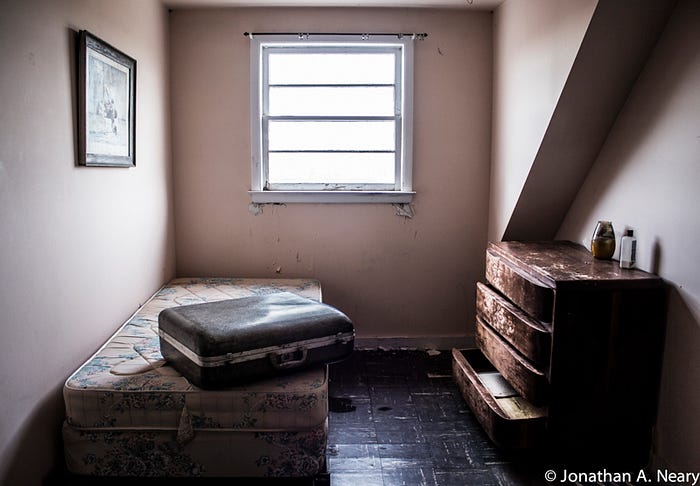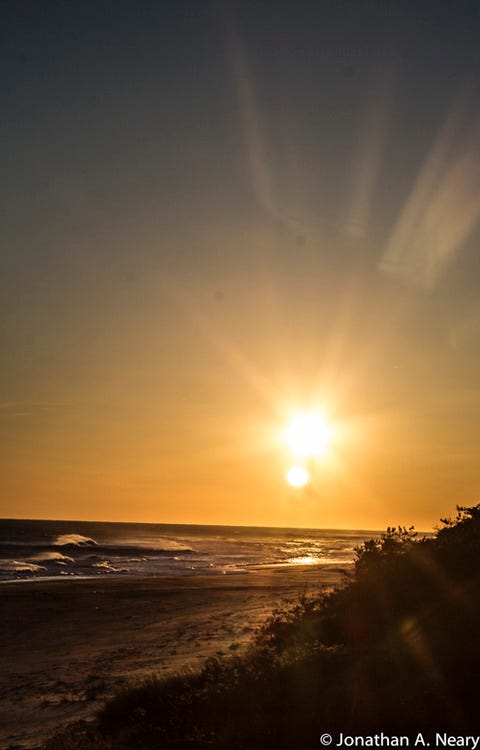
Eminent Domain: A Look at Montauk’s History
Precisely one week after we explored the bunkers of Montauk, one of my previous coadjutors agreed to join Delilah and I in a fresh expedition. Delilah, for the vast majority of you who haven’t had the pleasure of meeting her, is my four-legged companion: an Australian Kelpie I rescued earlier this year. Armed with little more than rumors of a recently abandoned house, and some hastily searched satellite images, we returned to the windy hamlet. Today, we would be exploring Montauk County Park, in search of the Hilda Lindley House.
Montauk in December is a baron, bitter, windswept wasteland of sorts, sharply contrasted by the golden hues of dead vegetation, and the deep cerulean depths of the atlantic, which inflict a rancorously frigid bite upon the exposed skin of the adventurous. It’s beautiful nonetheless: the endless rolling dunes and hills, the salty mist of the coast, the brilliant sunlight above; despite the temperature, I wouldn’t have wanted to be anywhere else in the world on this particular afternoon.

As we trekked over the muddy trails; we admired the land that was now dubbed “Indian Field,” and after a series of lucky guesses I would vaingloriously attribute to my adept navigational skills, we stumbled upon the weather beaten building we were looking for. In 1944, the U.S. Army Corps of Engineers built a Fire-Control Station on the land, used to spot enemy ships and submarines north of the Montauk Air Force Station (currently known as Camp Hero State Park). The structure was built primarily of concrete with narrow windows facing the shoreline, reminiscent of the bunker we explored at Shadmoor State Park the week prior. Its use in national defense only lasted six years, however, and was sold as Army surplus to Hilda and Francis Lindley in 1950. Now it stood, vacant, against the winds of the Atlantic, its paint chipping away as the dust settled within.


Hilda Lindley established the Concerned Citizens of Montauk (CCOM) in 1970, at a time when developers were seeking to build 1,800 houses on the 1,000+ acre Indian Field. After a struggle to preserve the land by Hilda and CCOM, Suffolk County agreed to act in their favor, but seized her house in the process through eminent domain, which was seen by many as political retaliation. The Lindleys did, however, receive a 40 year lease on their home, enabling them to stay until it expired in 2010. Currently, the house is seeing renewed attention from the Suffolk County Department of Parks, Recreation & Conservation, with new locks on the doors, and much of the immediate surrounding land cleared, although the interior has remained mostly untouched. What remains emits a colorfully vintage beauty, which took us by surprise amidst the uneasy feeling one gets when exploring the forgotten and abandoned.



Upstairs, the scene of an empty, open dresser, with a suitcase resting at the edge of a stripped-down mattress, inspired the imagination with thoughts of an alternate post-apocalyptic reality: one where the former occupants had just enough time to pack, but not enough time to flee. The windows still provided a sufficient barrier from the ocean wind, as the musty air around us stood still. Would someone return for their luggage? Or would it be churned into the rubble with the rest of this building in the days to come?

The final room we encountered surprised us with a still-made bed, which had been littered by the crumbling ceiling, and left accompanied by an empty tackle box upon a wrinkled terracotta blanket. Beneath the windows stood an old desk, showcasing a broken typewriter; a blank sheet of curling paper laid forever awaiting its purpose.


Many of the rooms are accented with a brilliantly suited fixture of dead wildflowers. The Lindleys had fought, at the cost of their own home, to preserve the very fields the arrangements were crafted from, and the flowers reminded us that Hilda and Francis had taken something designed for waging war, and turned it into a sanctuary of natural peace. The largest arrangement was adjacent to the front door, overlooking the living and dining rooms.

With every inch of the house explored, and the shadows growing taller on the wall, it was time for us to go. We took a break, first, to indulge in some snacks and green tea on what was once the Lindley family’s front deck, before suiting up for the trail. This time the guessing was removed, as Delilah kept her nose to the ground, retracing our fresh footsteps in the dirt. Without the trail and the endless woodlands, marshes, hills, and valleys, the magic of the Hilda Lindley House would have evaporated into the salty air. Isolated from the rest of the island and seemingly frozen in time, the parkland and the former fire-control station went hand-in-hand to create a unique and fascinating experience.

After over five miles worth of hiking (round-trip), we finally returned to Third House, where we had parked. The grass, still surprisingly lush one full week into December, was inviting as we sat down beside Delilah. She was happy for the chance to rest, as were we, as we took the time to catch our breath and reflect on our adventure. The wind was slightly more inviting by this point, as we had worked up a modest sweat rushing to beat the sunlight back to the car.

The last stop we made was at an ocean overlook along Old Montauk Highway. The blustery wind folded white caps against the surface of the unforgiving sea: a perfect summary of what made Montauk the hamlet that it is. The ocean was the reason people discovered this land; the reason a chunk of that land was named “Indian Field.” The ocean was the reason whalers and fishermen settled here, and still struggled to remain. The ocean was the reason the Hilda Lindley House was built, and why Montauk was crucial to our national defense during one of the greatest wars of our existence. And, most famously, the ocean is what drives the tourists and wealthy vacationers to the East End every summer, year after year. This was a summary of everything our day entailed, and the root of all our local history.

Note: Please be mindful of trespassing laws; seek permission whenever possible and DO NOT break and enter! Adhere to the policy of Leave No Trace, and take only pictures. I always make sure not to disturb anything and to leave every place the way I found it. Have fun exploring, folks!
